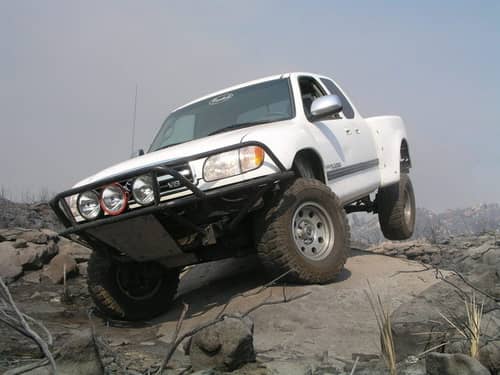Are you considering getting winter tires for your vehicle? If you live in a snowy climate where ice on the roads is expected, it’s a good idea to invest in some winter tires as these will make driving a lot safer.
What about after the winter season? Most drivers remove their winter tires and replace them with all season tires. The winter tires then begin to collect dust for the rest of the year until it’s winter season again.
Instead of having winter tires take up storage, you’re probably curious as to whether they perform well in mud during the non-winter seasons. No, winter tires would not do well in mud. Due to their rubber compound and tread type, winter tires are ill-equipped to handle the viscous qualities of mud.
Differences between all-terrain, mud-terrain and winter tires
There are a few different types of tires on the market, including all-terrain tires, mud tires, and winter tires. They all vary in thickness, rubber compound, and tread patterns.
All-terrain
All-terrain tires provide drivers with traction on all types of road surfaces, as well as for off-road driving. All-terrain tires have an open-tread design, which is similar to off-road tires; this is combined with the handling of street tires. All-terrain tires are not the best option for people who only drive on one type of surface, e.g., If you’re only driving on roads and highways and never venture off-road.

All-terrain tires perform well on all surfaces but are slightly noisier. You may find that it takes you somewhat longer to turn or brake when using all-terrain tires. Another disadvantage of choosing all-terrain tires is that they don’t have very good fuel efficiency. All-terrain tires have an estimated fuel efficiency of about 681.8 gallons a year.
The tread blocks on all-terrain tires are closer together. This provides greater contact with the surface of the road. It also allows the tires to be more flexible and have better grip when driving off the road. The threads and tread patterns allow the all-terrain tires to grip other surfaces effectively, including snow, mud, and sand.
Winter tires
Winter tires are great if there’s snow on the ground or if you’re driving in icy conditions. They have been specifically designed to remain pliable even in the coldest of temperatures. The problem with winter tires is that once the weather starts to get slightly warmer, their performance deteriorates. For this reason, it isn’t a good idea to use winter tires to drive in the mud.
Winter tires have been designed for people who regularly drive in snow or ice and should be used if the temperatures are lower than 7°C. Winter tires are the safest type of tire for driving in icy conditions as these can often prevent skidding and slipping.
If you happen to be in the market for some great winter tires, check on my short review on my favorite ones.
Mud-Terrain
Mud-terrain tires have more expansive spaces between their blocks than all-terrain tires do. This allows them to handle muddier conditions. However, mud-terrain tires used in the snow or sand are likely to struggle under such conditions.
This is a short but in-depth video on the different tire types:
The best type of tire for mud
Mud terrain tires are the for mud and off-roading. If there are rocks or other obstacles, you’ll be able to drive over these with more ease. They also handle off-road slopes better then all-terrain or winter tires. If you’re driving over dry or wet clay soil that needs a tire to dig in more, a mud-terrain tire would be the best option.
Another great feature of mud terrain tires is that they have the ability to self-clean. This is due to the design of the tread pattern. All-terrain tires can easily become packed with mud if driving over very muddy land.
Effect of winter tires on mud
Winter tires aren’t likely to be as effective for driving on mud as all-terrain or mud-terrain tires unless they are rated as mud and snow (M+S) tires. Winter tires have been designed for use in temperatures lower than seven degrees. When the temperature is as low as seven degrees, any mud on or off the road is likely to be frozen.
Winter tires don’t perform so well in warmer weather, and if you drive through mud, they are likely to become clogged. Winter tires have been designed using soft rubber that is resistant to hardening in colder climates. This type of tire isn’t great for warm weather, so you should change your tires when the seasons change. Many drivers own winter tires and all-terrain or all-season tires, and they swap them around when necessary.
How is driving on mud different from driving on snow?
If you’re driving through mud, your tires will normally sink into the ground. If the mud thick enough, your vehicle can become submerged and come to a halt. Muddy areas often have deep ruts that cause wheel spin and may be challenging to get out of.

If your car gets stuck in the mud, you should remain calm and try to reverse first. You may then be able to move forward again without incident. If you are unable to dislodge yourself from the mud, you can find some logs or stones and create a path which you can drive over. Sometimes rubber floor mats beneath your tires will work too.
Driving through snow is slightly different as the problems faced by drivers are likely to be skidding and slipping rather than getting stuck. While some snowy roads may be easy to drive on, you’ll need to be aware that there could be areas of black ice underneath the snow, which is likely to be very slippery.
If you suddenly come across unexpected ice or snow, this could be dangerous, particularly if you don’t have winter tires on your vehicle. It would help if you drove slowly and steadily in snowy conditions and should proceed with extreme caution.
What are mud and snow tires (M+S)?
Mud and snow tires, known as M+S for short, are tires that have been specifically designed for use in both the mud and snow. These types of tires have been approved by the Rubber Manufacturer’s Association and have the M+S designation printed on the side of the tire.
Mud and snow tires have deep grooves in their treads, and this offers drivers better performance in slick and slippery conditions. They have been designed to create better traction in colder climates.
M+S tires use rubber that can remain flexible even as the weather gets cold. They effectively provide grip and should be used in temperatures of below 45 degrees Fahrenheit. You’ll find that there are even some M+S tires that have studded treads to offer drivers more excellent traction. These types of tire have metal studs on their surface to dig into the mud, snow, and ice.
Are M+S tires better for mud or snow or both?
M+S tires have been designed to deal effectively with both mud and snow. It’s hard to truly say whether M+S tires are better for mud or snow. In general, M+S tires should be used in light snow and moderately muddy conditions.
Mud and snow tires differ slightly from winter tires as they work best in lighter snow. Winter tires have been designed to handle deep snow and icy conditions. Although M+S tires are great for the snow, it is best to choose a winter tire if you live in a climate where there’s likely to be deep snow or very icy roads for much of the winter.
If you are into off-roading and plan to drive through very muddy and boggy areas, you may like to buy mud-terrain tires as these are designed to handle muddier conditions then M+S tires.
When purchasing M+S tires, you must choose the right size of tire for your car. Consult your owner’s manual to see what size of tire you need. It’s essential that you get the right size of tire, as this will have an effect on performance.
If your car has a tire that’s even slightly too small or large, it’s likely that they won’t provide the advantages that you need in muddy or snowy conditions. Tires that are not the correct size for your vehicle will wear out sooner than they should and may also cause mechanical problems.
This video wasn’t specifically designed for Americans but it’s still helpful nonetheless:
Conclusion
Winter tires are not the best for driving in the mud unless they have the M+S mark, which means that they have been approved for use in mud and snow. These types of tires have been designed to deal with mud and light snow and can be used year-round.
If you have a 4X4 and enjoy driving off-road regularly, you may like to consider investing in all-terrain tires or mud-terrain tires. These have been designed specifically to deal with muddy conditions. Mud terrain tires are especially good if there’s a lot of wet clay-like mud that you need to get through. They have the correct type of treads to deal with the conditions without wheel-spinning or getting stuck. Mud terrain tires have even been designed to self-clean, which is an added bonus.
If you’re thinking of different ways to accessorize your truck or make it more functional, consider checking out my recommended accessories page. I spent a good amount of time picking out mods that can be useful for most pickup trucks.

